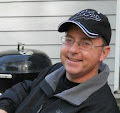I follow the same basic steps as Cody Grivno has explained in the Jan 2007 issue of Model Railroader. The first step is to spread the ballast between the tracks. I use a plastic spoon to sprinkle a spur or 4 feet of mainline, then carefully spread it between the ties so very little is laying on the rail sides or top of the track.
 |
| Spreading ballast between ties |
Next, I slide a pipette along the inside rails to wet the ballast with straight rubbing (isopropal) alcohol. Others recommend 70/30 diluted but other than the odor, I'm fine with full strength and you can get economical quart bottles at the drug store.
 |
| Apply alcohol as a wetting agent. |
The alcohol acts as a wetting agent to help the glue, next step, seep into the ballast and firmly adhere it. Once I let this set for 5 minutes or so, I come back with another pipette and apply
Woodland Scenes Scenic Cement.
After letting that dry overnight, I run a bead of white glue along the side of the track and use a small flat brush to evenly coat the side of the cork roadbed. I have tried 50/50 glue water mixture but I find the glue right out of the bottle works best for me. I come back with the plastic spoon and sprinkle the ballast along the glue line.
 |
| Spreading the glue to the side of the roadbed |
I try to be a little sparing with the ballast here since anything that does not directly touch the glue will get sucked up in the shop vac. I go over this section with a 1" foam brush and tap along the top of the ties to push the loose ballast into the glue and then pull along the side to get the profile.
 |
| Pressing the ballast into the glue along the roadbed |
Again, this dries overnight and the final picture below shows the result. The final step is to go back and dress up any gaps but I will complete this rough texturing first around the layout before I come back to that.
 |
| Basic ballast - I will eventually come back and fill in the gaps |






No comments:
Post a Comment